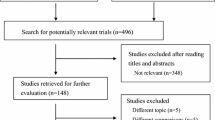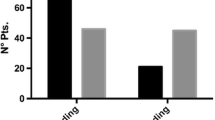Abstract
PURPOSE: Glyceryl trinitrate ointment acts as a dilator of the internal anal sphincter. It has been used as a treatment modality that replaces the lateral sphincterotomy in chronic anal fissures. When glyceryl trinitrate ointment is applied to the wound from a hemorrhoidectomy, it is thought that it will shorten the healing time and decrease postoperative pain. Our study focused on the efficacy of using 0.2 percent glyceryl trinitrate ointment to shorten the healing time after a hemorrhoidectomy. METHODS: A randomized, prospective, double-blind, and placebo-controlled study was designed. The power test indicated that 55 patients should be in each group to give a 90 percent chance of finding a 30 percent difference in healing time. The selection criteria for inclusion in this study were patients with third-degree or fourth-degree hemorrhoids and patients undergoing hemorrhoidectomies for three or more piles. From November 2000 to July 2001, the first 110 patients to meet our criteria were selected, 55 in the nitroglycerin group and 55 in the placebo group. The same physician performed all of the hemorrhoidectomies, and intravenous patient-controlled analgesia was not used. Cases involving other procedures for fissures or fistulas were excluded. The patients randomly received glyceryl trinitrate and placebo ointments from the pharmacologist. The pain score was checked using a visual analog scale (minimum = 0, maximum = 10) during the hospital stay, and complete wound healing was checked at three weeks after the operation. Demands for analgesics and the frequency of postoperative complications were recorded. RESULTS: When the trial was completed, 49 patients remained in the nitroglycerin group and 53 patients in the placebo group. No significant differences in the gender and the age distributions, the number of excised piles, the time for the procedures, the length of hospital stay, and the consumed amounts of analgesics existed between the two groups. The pain score in the nitroglycerin group showed a significant difference with the repeated measures analysis (P < 0.001). The wound healing rates at three weeks postoperative were 74.5 percent in the nitroglycerin group and 42 percent in the placebo group (P = 0.002). There was no significant increase in complications in the nitroglycerin group. CONCLUSION: More rapid healing of hemorrhoidectomy wounds without any specific complications was effected by 0.2 percent glyceryl trinitrate ointment.
Similar content being viewed by others
References
PB Loder MA Kamm RJ Nicholls RK Phillips (1994) ArticleTitleReversible chemical sphincterotomy by local application of glyceryl trinitrate Br J Surg 81 1386–1389
H Bacher HJ Mischinger G Werkgartner et al. (1997) ArticleTitleLocal nitroglycerin for treatment of anal fissures Dis Colon Rectum 40 840–845
J Pitt S Williams PM Dawson (2001) ArticleTitleReasons for failure of glyceryl trinitrate treatment of chronic fissure-in-ano Dis Colon Rectum 44 864–867
ML Kennedy S Sowter H Nguyen DZ Lubowski (1999) ArticleTitleGlyceryl trinitrate ointment for the treatment of chronic anal fissure Dis Colon Rectum 42 1000–1006
S Rattan S Chakder (1992) ArticleTitleRole of nitric oxide as a mediator of internal anal sphincter relaxation Am J Physiol 262 107–112
KB Kua HM Kocher A Kelkar AG Patel (2001) ArticleTitleEffect of topical glyceryl trinitrate on anodermal blood flow in patients with chronic anal fissures ANZ J Surg 71 548–550
HH Chen (1999) ArticleTitleAnal manometric findings before and after hemorrhoidectomy Changgeng Yi Xue Za Zhi 22 25–30
Y Arabi J Alexander-Williams MR Keighley (1977) ArticleTitleAnal pressures in hemorrhoids and anal fissure Am J Surg 134 608–610
G Galizia E Lieto P Castellano L Pelosio V Imperatore C Pignatelli (2000) ArticleTitleLateral internal sphincterotomy together with haemorrhoidectomy for treatment of haemorrhoids Eur J Surg 166 223–228
IT Khubchandani JF Reed (1989) ArticleTitleSequelae of internal sphincterotomy for chronic fissure in ano Br J Surg 76 431–434
DC Nyam JH Pemberton (1999) ArticleTitleLong-term results of lateral internal sphincterotomy for chronic anal fissure with particular reference to incidence of fecal incontinence Dis Colon Rectum 42 1306–1310
SR Gorfine (1995) ArticleTitleTreatment of benign anal disease with topical nitroglycerin Dis Colon Rectum 38 453–457
EA Carapeti MA Kamm BK Evans RK Phillips (1999) ArticleTitleTopical diltiazem and bethanechol decrease anal sphincter pressure without side effects Gut 45 719–722
C Antropoli P Perrotti M Rubino et al. (1999) ArticleTitleNifedipine for local use in conservative treatment of anal fissures Dis Colon Rectum 42 1011–1015
WH Jost K Schimrigk (1994) ArticleTitleTherapy of anal fissure using botulin toxin Dis Colon Rectum 37 1321–1324
JN Lund NC Armitage JH Scholefield (1996) ArticleTitleUse of glyceryl trinitrate ointment in the treatment of anal fissure Br J Surg 83 776–777
AF Ciccaglione L Grossi G Cappello et al. (2000) ArticleTitleShort- and long-term effect of glyceryl trinitrate (GTN) ointment 0.2% and 2% on anal canal pressure in patients with chronic anal fissures Dig Dis Sci 45 2352–2356
KR Lee KA Cho DY Hwang et al. (2000) ArticleTitleTopical glyceryl trinitrate (GTN) versus conservative treatment in chronic anal fissure J Korean Soc Coloproctol 16 360–364
G Dorfman M Levitt C Platell (1999) ArticleTitleTreatment of chronic anal fissure with topical glyceryl trinitrate Dis Colon Rectum 42 1007–1010
DF Altomare M Rinaldi G Milito et al. (2000) ArticleTitleGlyceryl trinitrate for chronic anal fissure-healing or headache? Results of a multicenter, randomized, placebo-controlled, double-blind trial Dis Colon Rectum. 43 174–181
HJ Wasvary J Hain M Mosed-Vogel P Bendick DC Barkel SN Klein (2001) ArticleTitleRandomized, prospective, double-blind, placebo-controlled trial of effect of nitroglycerin ointment on pain after hemorrhoidectomy Dis Colon Rectum 44 1069–1073
M Jonas DA Barrett PN Shaw JH Scholefield (2001) ArticleTitleSystemic levels of glyceryl trinitrate following topical application to the anoderm do not correlate with the measured reduction in anal pressure Br J Surg 88 1613–1616
Author information
Authors and Affiliations
About this article
Cite this article
Hwang, D., Yoon, SG., Kim, H. et al. Effect of 0.2 Percent Glyceryl Trinitrate Ointment on Wound Healing After a Hemorrhoidectomy. Dis Colon Rectum 46, 950–954 (2003). https://doi.org/10.1007/s10350-004-6692-0
Issue Date:
DOI: https://doi.org/10.1007/s10350-004-6692-0




